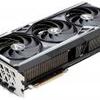Graphics card temperatures
Graphics card temperatures
So here we'll have a look at GPU temperatures. First up will be IDLE (desktop) temperatures as reported through the software on the thermal sensors of the GPU. Overall anything below 50 Degrees C is considered okay, anything below 40 Degrees C is admirable. We add some other cards at random that we have recently tested in the chart. But what happens when we are gaming? We fire off an intense game-like application at the graphics card and measure the highest temperature of the GPU.
So with the card fully stressed we kept monitoring temperatures and noted down the GPU temperature as reported by the thermal sensor. These tests have been performed with a 20~21 Degrees C room temperature, this is a peak temperature based on a GPU stress loop.
G is gaming mode with a higher fan profile, S is Silent mode.
Long Duration Stress Temperature and GPU Throttling clock
- Extreme mode; higher TGP 449, higher boost dynamic ~2820 MHz, higher fan RPM ~1900.
- Normal; TGP 435, boost dynamic ~2745 MHz, fan RPM ~1800.
Turbo Mode
Normal Mode





